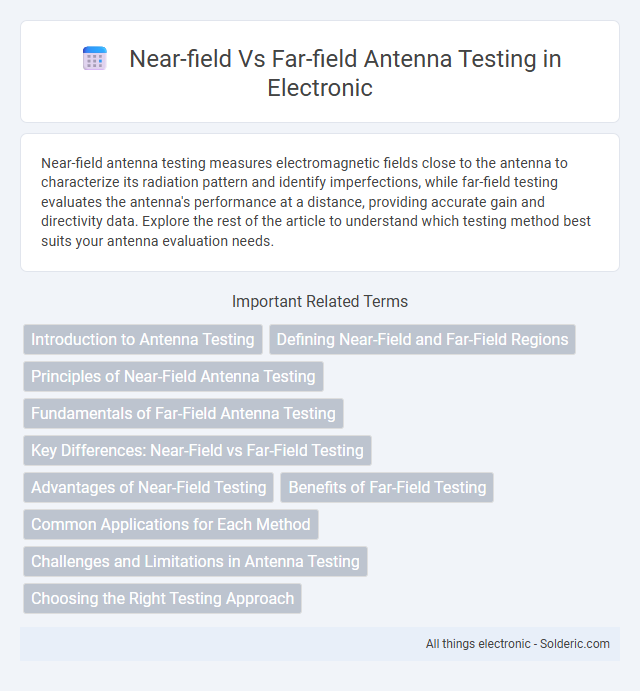Near-field antenna testing measures electromagnetic fields close to the antenna to characterize its radiation pattern and identify imperfections, while far-field testing evaluates the antenna's performance at a distance, providing accurate gain and directivity data. Explore the rest of the article to understand which testing method best suits your antenna evaluation needs.
Comparison Table
| Aspect | Near-Field Antenna Testing | Far-Field Antenna Testing |
|---|---|---|
| Testing Distance | Within a few wavelengths of the antenna | At a distance greater than 2D2/l (D = antenna largest dimension, l = wavelength) |
| Measurement Environment | Compact anechoic chambers or labs | Open range or large outdoor facilities |
| Data Captured | Complex near-field patterns, including amplitude and phase | Radiation patterns, gain, and directivity under free-space conditions |
| Accuracy | High spatial resolution; requires mathematical transformation to far-field | Direct measurement of far-field parameters |
| Test Time | Typically longer due to detailed scanning | Faster, with simpler measurement setup |
| Cost | Higher due to specialized equipment and processing | Lower, but requires larger physical space |
| Applications | Small antennas, phased arrays, and complex near-field analysis | Large antennas and validation of antenna performance in real conditions |
Introduction to Antenna Testing
Antenna testing evaluates performance characteristics such as radiation pattern, gain, and efficiency to ensure optimal functionality. Near-field testing measures electromagnetic fields in close proximity to the antenna, enabling detailed spatial analysis and accurate diagnosis of antenna behavior. Far-field testing assesses the radiated signals at large distances, providing practical insights into real-world antenna performance in communication systems.
Defining Near-Field and Far-Field Regions
The near-field region of an antenna is the area close to the antenna, typically within a distance of less than 2D2/l, where D is the largest antenna dimension and l is the wavelength, characterized by reactive and radiating fields that do not exhibit a stable radiation pattern. The far-field region lies beyond this boundary, where the electromagnetic waves behave as plane waves, allowing accurate measurement of antenna radiation patterns, gain, and directivity. Understanding the distinction between near-field and far-field regions is essential for selecting appropriate antenna testing methods that ensure precise characterization of antenna performance.
Principles of Near-Field Antenna Testing
Near-field antenna testing measures electromagnetic fields in close proximity to the antenna to accurately characterize its radiation pattern and impedance. This method captures amplitude and phase data across a scanning surface, enabling precise transformation to the far-field pattern through mathematical algorithms such as the Fourier transform. Near-field testing offers high-resolution measurements and compact test setups, making it ideal for complex antenna designs and environments with limited space.
Fundamentals of Far-Field Antenna Testing
Far-field antenna testing measures the radiation pattern and gain at distances where the antenna's angular field distribution remains constant, typically several wavelengths away from the antenna. This testing region ensures plane wavefronts, providing accurate characterization of antenna parameters such as directivity and sidelobe levels. Accurate far-field measurements require a large test range and precise alignment to minimize multipath and ensure reliable data.
Key Differences: Near-Field vs Far-Field Testing
Near-field antenna testing measures electromagnetic fields close to the antenna, capturing detailed phase and amplitude data, which enables precise characterization of antenna parameters in confined spaces. Far-field testing evaluates radiation patterns at large distances where the wavefronts are planar, providing direct insight into antenna gain, directivity, and beamwidth crucial for real-world performance assessment. Your choice between near-field and far-field testing depends on available space, measurement accuracy, and the specific antenna design requirements.
Advantages of Near-Field Testing
Near-field antenna testing offers precise measurement of antenna radiation patterns and impedance by capturing detailed electromagnetic field data close to the device, enabling accurate characterization in controlled environments. This method reduces the required testing space compared to far-field testing, making it ideal for compact or indoor facilities and improving testing efficiency. You benefit from enhanced diagnostic capabilities, allowing adjustments and optimization before the antenna operates in real-world far-field conditions.
Benefits of Far-Field Testing
Far-field antenna testing provides highly accurate measurements of radiation patterns, gain, and directivity by simulating real-world propagation conditions at considerable distances from the antenna. This method eliminates near-field coupling effects and offers precise characterization of antenna performance, critical for applications requiring exact beam shaping and interference reduction. Your designs benefit from standardized and repeatable testing conditions, ensuring reliable performance verification compliant with industry standards.
Common Applications for Each Method
Near-field antenna testing is commonly used in applications requiring precise measurements of antenna radiation patterns and electromagnetic field characteristics in controlled environments, such as in aerospace, defense, and telecommunications industries. Far-field testing suits large-scale or outdoor environments where antenna performance assessment under real-world conditions is essential, often applied in satellite communications, broadcast transmissions, and radar systems. Both methods play critical roles in antenna design validation, ensuring compliance with regulatory standards and optimizing system efficiency.
Challenges and Limitations in Antenna Testing
Near-field antenna testing presents challenges such as requiring complex measurement setups and advanced computational models to accurately transform data into far-field patterns. Far-field testing faces limitations including the need for large, open spaces or anechoic chambers to minimize interference and ensure reliable results. Both methods are constrained by factors like environmental noise, equipment precision, and the difficulty of capturing accurate data for antennas with complex geometries or large sizes.
Choosing the Right Testing Approach
Choosing the right antenna testing approach depends on the frequency, size, and environment of your device. Near-field testing provides detailed measurements in a controlled, confined space ideal for small antennas or complex radiation patterns, while far-field testing captures accurate radiation characteristics in open areas suitable for larger antennas and higher frequencies. Understanding these differences ensures you optimize accuracy and reliability in your antenna performance evaluations.
near-field vs far-field antenna testing Infographic

 solderic.com
solderic.com